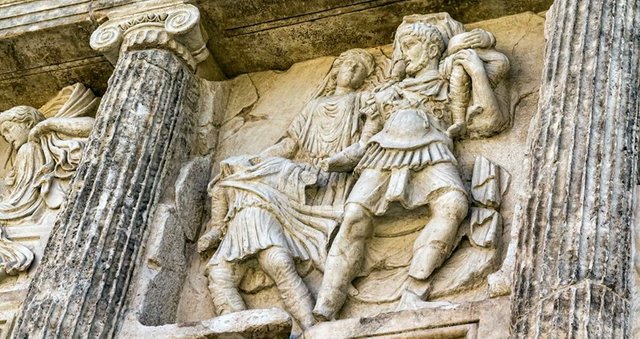The ancient city of Aphrodite, the goddess of love - Aphrodisias #10
As a Greek I first thought of the Greek word próbata (sheep) - but it was not clear what the word "sheep" had to look for on the wall of a town hall (whether a parallel should be drawn between the parliamentarians and "sheep" undecided). As it turned out, it is the Latin word probata written in Greek letters. It means "tested and approved".
The interrelationships were presented as follows: Larger blocks, probably from a demolished building, were used for the construction of the town hall. The blocks were declared suitable by a master builder who wrote probata in red ink. Today he would rather write "o.k.". You probably already knew in advance where to place the blocks, because they all form a uniform layer that runs around the building.
Of the numerous signs of stonemasons, which are in the town hall, a short lettering is emphasized. At the end of the corridor behind the stage of the town hall, windows are opening. In addition to a window can be seen with great difficulty and only under special lighting conditions the text DEKATAKLES. One recognizes the word katakleis (window), even if it is not sure what DE means. For example, the abbreviation of de (ka) = ten or the end of ide = see? Nevertheless, one can assume that the text instructed the construction workers to leave room for a window after this wall block. That Grati are connected with ideological, political and religious conicts is well known to us. For example, Grati in Pompei gives us a vivid impression of the election propaganda in this city. However, the Grati do not speak "by themselves" - they can only be classified in a historical context, if one considers the literary, documentary and archaeological sources. Fortunately, we have such sources in Aphrodisias.
The Grati relevant to the history of religion date back to late antiquity (fourth to sixth century AD), a time charged with religious conflict. The Grati affect all three religious groups attested for this time in Aphrodisias: Christians, Gentiles and Jews. The Tolerance Edict of 311 created a "market of religions" in Asia Minor; Christians, Jews and Gentiles competed among themselves. The speeches of the Church Fathers leave no doubt as to the success of Judaism, but they also testify to the fierce resistance of the Gentiles. That the Christians documented the triumphant progress of their religion by carving the cross on the walls of pagan temples is well documented.
In Aphrodisias the militant argument of the followers of the Greek religion with the Jews until the sixth century is interesting. The existence of a large Jewish community is recorded by two texts recorded on a pillar (fourth or fifth century AD). They name the surnames, patronymic surnames and in part the job titles of 68 Jews, three proselytes and 52 "God-fearers", ie sympathizers of Judaism. Among the godly are rich and important men, including nine members of the council.

